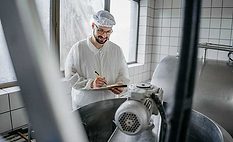
SSOPs
Sanitation Standard Operating Procedures (SSOPs) are written procedures or programs used to maintain equipment and the facility environment in a sanitary condition for food processing, and are a fundamental part of a food safety plan.
Articles
More ArticlesNever miss the latest news and trends driving the food safety industry
eNewsletter | Website | eMagazine
JOIN TODAY!Copyright ©2025. All Rights Reserved BNP Media.
Design, CMS, Hosting & Web Development :: ePublishing


